Everyone loves the latest Volkswagen GTI. Even this reviewer, who found the previous two generations insufficiently engaging, loves the latest Volkswagen GTI. But there's always room for improvement, right? The GTI might be the best front-wheel-drive sport compact, but for many driving enthusiasts front-wheel drive is wrong-wheel drive. What if the GTI were offered with all-wheel drive, plus another 72 horsepower to more than offset the resulting weight gain? This describes the new Golf R. Theoretically the Golf R should be a better car than the GTI. But is it?
I've pitted the GTI against the Subaru WRX. The Golf R must take down bigger game, the WRX STI.
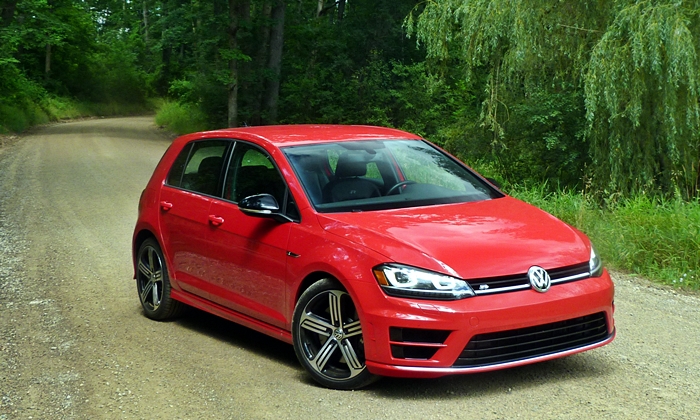
To distinguish a Golf R from a GTI, look for these wheels. OR a little R in the grille. more Golf / GTI photos
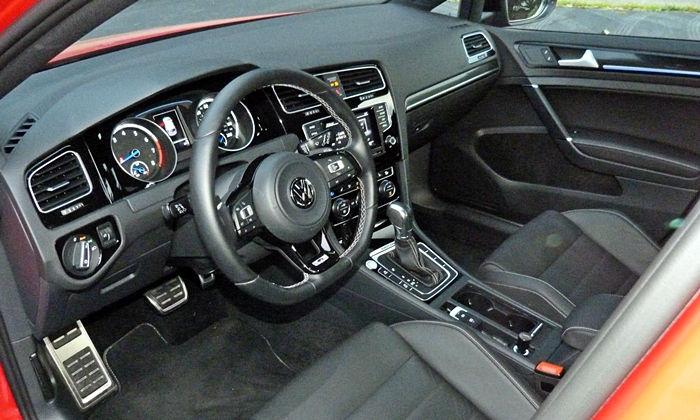
If you've seen the inside of a GTI, you know what to expect. Standard leather, so no plaid cloth.
| |
Compared to the WRX |
| Materials & workmanship |
 Better
Worse
Better
Worse
|
Like the GTI, the Golf R feels more solidly constructed and has more upscale interior materials than the competition from Subaru, Ford, and so on. The doors close with a reassuring ker-chunk. Bear in mind, though, that the Golf R costs significantly more than the GTI, so this level of workmanship is less of a surprise and more expected.
One exception: the leather upholstery has the dry, slightly rough feel usually associated with quality leathette, such as that in BMW and Mercedes. Those seeking soft, supple leather won't find it here.
| Powertrain performance |
 Better
Worse
Better
Worse
|
With 72 more horsepower than the GTI and twice as much rubber transferring this power to the pavement, the Volkswagen Golf R is a very quick car. With a hard launch (facilitated by standard launch control) it can get from a dead stop to 60 MPH in under five seconds, perhaps a second quicker than a GTI with the optional Performance Package (which bumps horsepower from 210 to 220 and adds a limited-slip differential). Though it is a little more powerful, at least according to the spec sheet (305 vs. 292 horsepower), and also tips the scales at around 3,400 pounds, the Subaru WRX STI isn't quite as quick.
Why not? Credit the lightning-quick shifts of the VW's six-speed dual-clutch automated transmission (DSG in VW parlance, DCT in generic). A human driver cannot shift the Subaru's six-speed manual transmission nearly as quickly as the DSG can shift itself.
But what if you prefer the more thorough involvement provided by a manual transmission? The Golf R is available with one for 2016. Just expect your jollies to come at the expense of at least a few tenths.
Beyond full-throttle acceleration, the Golf R's performance isn't much of an improvement over the GTI. The opposite, in fact. The way to get more power without increasing the size of the engine (still 2.0 liters) is to pump more air into the engine, which tends to require a larger turbo. Larger turbos take longer to spool up. As a result, in typical driving the Golf R engine's power delivery feels more laggy and less linear--like that of the non-STI 2.0-liter Subaru WRX, if not to the same degree. The WRX STI has a 2.5-liter engine, so it doesn't require nearly as much boost to yield its 305 horsepower.
Then there's the sound made by the Golf R's engine, or by the audio system in an attempt to enhance the inherent sound of the engine. There's quite a bit of this sound in the Golf R, especially in sport mode, and it's not of an appealing quality. A deepish monotone drone, it sounds entirely synthetic even if it's not. The "whump" evoked each time the DSG makes one of its firm, lightning-quick shifts, though, I like.
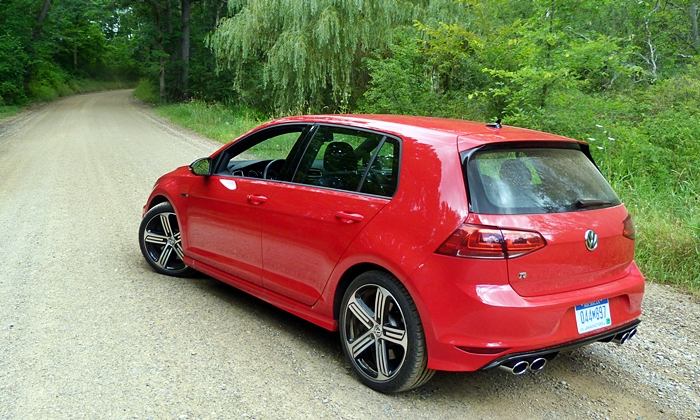
The latest Golf is the most attractive yet. My favorite angle. Quad tips on the Golf R.
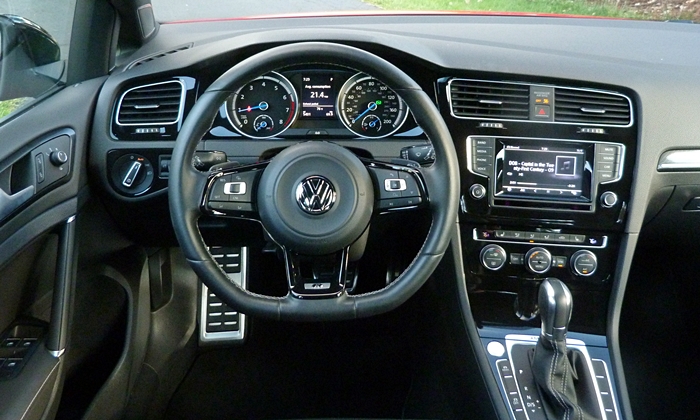
Well-designed controls. This is a 2015. 2016s have much-improved infotainment systems.
| Fuel economy |
 Better
Worse
Better
Worse
|
Fuel economy as a reason to buy a 292-horsepower, all-wheel-drive Volkswagen Golf R, really? Well, among cars with about 300 horsepower the Golf R's EPA ratings of 23 MPG city and 30 MPG highway rank near the top. Want the manual transmission? It does one MPG worse in the city, but one MPG better on the highway.
In comparison, the Subaru WRX STI is a gas guzzler, with EPA ratings of 17 MPG city and 23 MPG highway.
On the other hand, the Golf R isn't quite as efficient as the GTI (25/33 with the DSG, 25/34 with the manual).
| Driving position & visibility |
 Better
Worse
Better
Worse
|
Too often I find I cannot enjoy an otherwise excellent car on public roads because the windshield is raked too far back (yielding a deep instrument panel), the windows are too small, you sit too low, or all of the above. Neither the Volkswagen nor the Subaru suffers from these issues. Outward visibility is excellent from their driver seats, contributing to my confidence while driving them.
And the seats themselves? When the road turns twisty, both have front seats that provide good lateral support without sacrificing driver comfort. (Though I do find the buckets in the regular Golf more form-fitting and even more comfortable than the firmer, more heavily bolstered sport buckets in the GTI and Golf R.) The Golf R's driver seat includes four-way power-adjustable lumbar support. The Subaru's includes no lumbar adjustment.
In their latest iterations, both the Volkswagen and the Subaru are roomier than in previous generations. Four adults can now fit comfortably in either. But only the VW includes rear air vents.
| Cargo capacity |
 Better
Worse
Better
Worse
|
The Volkswagen Golf R is only offered as a hatchback, while the Subaru WRX STI is only offered as a sedan. Consequently, you can pack far more of your stuff into the back of the Golf R.
The upcoming 350-horsepower all-wheel-drive Ford Focus RS also will be a hatchback, but the VW can still hold more cargo, 53 vs. 45 cubic feet.
| |
Compared to the WRX |
| Ride smoothness |
 Better
Worse
Better
Worse
|
In ride smoothness, the Volkswagen GTI scored a clear win over the Subaru WRX. This advantage is pretty much gone with the new Golf R, which has a much firmer suspension than the more touring-oriented previous generation Golf R. I haven't driven the WRX STI on public roads, but the Golf R's suspension felt nearly as firm and unforgiving as the regular WRX's. Both cars feel jumpy over small road imperfections, especially if you're just trying to have a relaxing commute. Granted, this issue fades when the cars are driven con brio.
The tested Golf R did not have the adaptive dampers that are packaged with navigation, a Fender audio system, and 19-inch wheels. These dampers should improve ride quality, but the lower profile tires they're bundled with should have the opposite effect.
| |
Compared to the WRX |
| Handling |
 Better
Worse
Better
Worse
|
My feelings about the Volkswagen Golf R's handling could hardly be more mixed.
On the positive side of the ledger, the new, more aggressively tuned Golf R is much more capable through curves than the touring-oriented previous iteration. The new car feels extremely well planted on just about any road. If something fazes it, I didn't encounter it. You feel the bumps, but they don't knock the car off your specified line. Few cars are easier to drive near their full potential on a track.
In contrast, the first time I drove the Subaru WRX STI on a track a twitchiness to its steering weirded me out. Though this twitchiness was caused by a limited-slip front differential as a byproduct of its efforts to maximize traction, through the steering wheel it was difficult to distinguish from tire slip (which was likely non-existent).
On the other side of the ledger, the Golf R isn't nearly as fun to drive as the WRX STI. The Subaru responds to both steering and throttle inputs with more immediacy and force. Its personality occupies a much broader dynamic range. It might not be quite as predictable, but it's a lot more exciting.
In typical real-world driving, I also had more fun driving the GTI than the Golf R. The higher limits of the later, below which there's little fun to be had, aren't often approached on public roads, at least not on those in my area.
For those who care about track times, Car and Driver lapped a road course at Virginia International Raceway (VIR) nearly two seconds more quickly in the WRX STI than in the Golf R. Credit is likely due the WRX STI's far more sophisticated drivetrain, with limited-slip differentials at both ends and an adjustable center differential. The Golf R relies on selective application of the brakes to provide the benefits of limited-slip differentials, but this can't fully substitute for the real thing.
| Price or payments |
 Better
Worse
Better
Worse
|
The 2016 Volkswagen Golf R starts at $36,470, nearly $1,000 more than the Subaru WRX STI. But it includes about $1,500 in additional standard features. Adjust for these, and the two cars are priced similarly, with a slight value advantage to the VW.
The new model year's Golf R options include $1,100 for the 2015's mandatory DSG transmission, $2,245 for the DCC (adaptive dampers) and Navigation Package, and $1,295 for a Driver Assistance Package.
The last, new for 2016, includes the collision warning systems and adaptive cruise control. These features were only available on the Subaru for 2015 (earning the GTI a feature availability "why not"). But these features, while offered on the regular WRX, are not offered on the WRX STI--probably because hardcore driving enthusiasts tend to disparage rather than desire them. For those who do want them, the shoe has shifted to the other foot.
The VW's infotainment system was well behind the curve in the 2015. For 2016 this weakness has also been rectified, and then some. The new system is the first from any auto maker to support Android Auto, Apple Carplay, AND Mirrorlink, all of which enable phone-based apps to be displayed and controlled using the car's touchscreen.
For those who want navigation and a power driver seat, a Golf R with the DCC and Navigation Package undercuts a WRX STI Limited by over $2,000 despite including about $600 in additional content.
A stronger pricing challenge comes from within the VW's own camp. A loaded Golf R lists for $4,535 more than a GTI SE with Performance and Lighting Packages, even though it lacks the latter's sunroof. Not a bad bump for the extra power and all-wheel drive--except that the GTI can actually be more fun to drive.
Looking in the other direction, the Audi S3 is almost identical mechanically to the Golf R, but lists for $6,430 more in sedan form (a convertible is also offered). You cannot get a manual transmission in the S3. Another key difference: while a sunroof isn't available on the Golf R, a large one is standard on the S3 sedan (and equal in value to the entire $1,000 content difference between the two cars in base trim).
Want the 19-inch wheels, adaptive dampers, adaptive cruise, nav, and high-powered audio systems offered on both cars? Then the price difference widens to $10,540 (about $2,200 of which can be accounted for through the S3's additional features). How much is the additional prestige of the Audi worth to you? If you don't care about badges, then consider the Golf R as an S3 for $6-10k less ($5-8k less after adjusting for the Audi's additional content).
| Exterior styling |
 Better
Worse
Better
Worse
|
The latest WRX STI continues the fine Subaru tradition of anti-style design. If not for the flared fenders, body kit, and so forth, it would look as boring and dated as the Impreza on which it continues to be based.
The Golf R's exterior is far more artful, yet less flashy. VW has done much less to distinguish its high-performance car from the model on which it is based. Only keen-eyed observers will know they aren't looking at a GTI, or even a regular Golf. For some people this relative invisibility (in colors other than bright red, at least) could be a bonus. Others might wish, as with its handling, that the Golf R's styling was more dramatic.
With a much more powerful engine and all-wheel drive, the new Volkswagen Golf R can out-accelerate and out-corner the GTI. Like the GTI, it has a nicely finished interior with more room for passengers and cargo than other compact hatchbacks. Plus much better fuel economy than any car with its performance has any right to have. It's a car that can serve very well both on a track and in daily life.
Well, except that the ride (with the standard suspension at least) can feel overly jumpy and bumpy when you're just trying to relax from Point A to Point B. Some forgive the at least equally annoying ride in the WRX STI because that car employs aggressive tuning to deliver visceral thrills in quantity. The Golf R, in contrast, isn't much fun unless driven like you stole it, and even then isn't as engaging as the Subaru. In most driving the less expensive, smoother-riding GTI also happens to be more fun to drive. For better or for worse, the Golf R's styling is as low on drama as its handling.
This makes the Golf R the Volkswagen for those who want to be quickest around the track with the least drama, even if this also means less fun. Or who want performance similar to that of the WRX STI, in a less dramatic, more adult package.
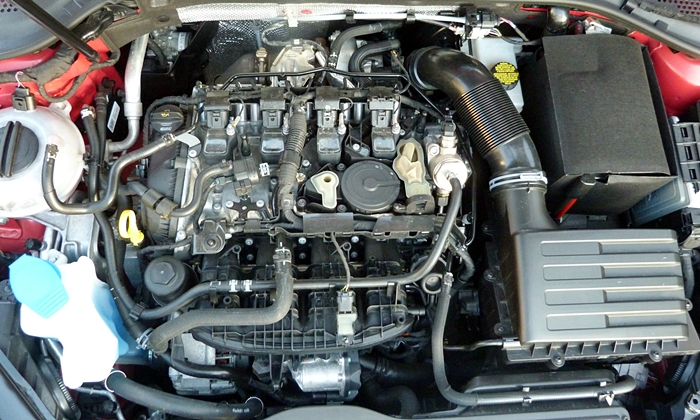
No eye candy under the engine cover, either, but everything is neatly assembled.
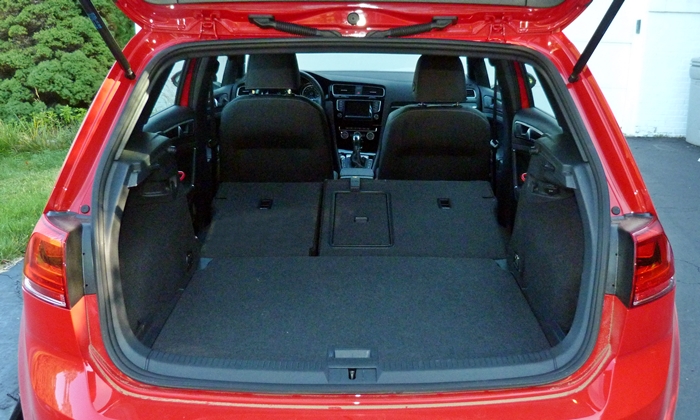
High-performance cars don't come much more versatile than the Golf R.
See more 2015 Volkswagen Golf / GTI photos
Volkswagen provided a Golf R for a week with a tank of gas. Subaru provided cars at a regional media association event.









